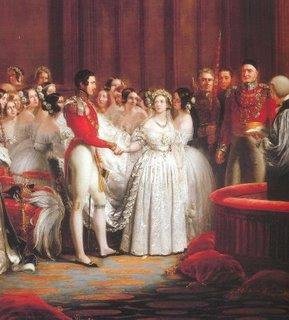A queen starts a new tradition
jmp.press@gmail.com
Mark Powell is on family leave. This column is reprinted from 2016.
Wedding dresses were not always white. In olden days, the bride might wear a wedding dress of royal purple. Or midnight blue. …
This item is available in full to subscribers.
Subscribe to continue reading. Already a subscriber? Sign in
Get 50% of all subscriptions for a limited time. Subscribe today.
Please log in to continueNeed an account?
|
A queen starts a new tradition
jmp.press@gmail.com
Mark Powell is on family leave. This column is reprinted from 2016.
Wedding dresses were not always white. In olden days, the bride might wear a wedding dress of royal purple. Or midnight blue. Or bright crimson.
Instead it’s white. Always white. In a time when traditions are dropping like pins falling in a bowling alley, people cling to the white wedding gown.
But did you know a frumpy British queen remembered for dressing in deepest black started it? And that a very practical, secret reason was behind her color selection?
England was gripped with excitement in early 1840. Her Majesty Victoria, by the Grace of God, of the United Kingdom of Great Britain and Ireland, Queen, Defender of the Faith (her official title) was getting married. This was the first time a sitting English queen had wed in nearly 300 years.
The 20-year-old Victoria was deliriously happy. She was passionately in love with her fiance (and cousin), Prince Albert of Saxe-Coburg and Gotha. When she proposed to him (as royal protocol dictated, and in German, because Albert spoke little English), royal wedding planners rolled into action.
Up till then, brides wore a rainbow of colors on their wedding day. Their gowns were elaborate, sometimes even stitched with threads of silver and gold. Royal brides sometimes walked down the aisle in thick, bright red dresses accompanied by rich furs, crowns and jewels.
But Victoria wasn’t buying it. A willful and headstrong child, she became a willful and headstrong monarch as well. This was, after all, the queen who popularized the Christmas tree, established the custom of afternoon tea time and launched Royal Jubilees to celebrate her years on the throne. If Victoria wanted to do something, she did it. And in 1840, she wanted a different type of wedding dress.
Forget the royal robes, she said. I’m making my wedding vows as a woman, not a queen. There would be none of the traditional gaudiness, not even a crown or tiara. She would appear, she said simply as a woman pledging herself to the man she loved.
Bride or not, the Queen of England is still the head of state. And her royal advisers realized the wedding presented a PR bonanza. Britain was in the midst of the Industrial Revolution just then, and the introduction of machines was sending its textiles sector topsy-turvy. Machine laces were crippling sales of traditional handmade laces, putting thousands of skilled artisans out of work. Her Majesty’s wedding gown was an ideal way to showcase this traditional British craft. Victoria agreed, and a large hunk of handmade Honiton lace was purchased.
And what better way to show off the lace, her dress designer said, than on white satin. Again, Victoria loved it. But there was another practical (and secret) consideration here as well: white was cost-effective. Prince Albert came from a cash-strapped royal family and didn’t bring much financially to the union. The royal court was unsure how crazy taxpaying Britons would be about footing the bill to support a broke royal consort who didn’t even speak their language. So they were cautious. The wedding wasn’t done on the cheap … but money wasn’t splashed around like it was going out of style, either. White satin was a safe bet.
So when Victoria stood at the altar in St. James Palace on February 10, 1840, her guests couldn’t believe their eyes. Victoria described it this way in her diary: “I wore a satin dress, with deep flounce of Honiton lace. My jewels were my Turkish diamond necklace & earrings & my dear Albert’s beautiful sapphire brooch.” She wore an elaborate veil made of the same lace, and orange blossoms (a traditional symbol of fertility) as trim and on top of the veil.
The reaction? Aristocrats yawned. They thought the gown utterly lacked style.
But commoners, loved it. They saw understated elegance. The fact that their queen wore simple white, an inexpensive color they could afford, signaled it was good enough for them, too. Queen Victoria had, unintentionally and unknowingly, given white her seal of approval. And people instantly embraced it weddings.
As for Victoria and Albert, theirs was a fabled marriage. They fought like tigers (like many couples, they struggled to devise a power sharing system that worked for them), then passionately made up … with “passionately” being the key word; they wound up having nine children. (Apparently, there was a whole lot of making up.)
When Albert died at age 42 in December 1861, Victoria was devastated. She never stopped mourning him, and wore nothing but deepest black for the remaining 40 years of her life. But when she died in 1901, she was buried with her lace wedding veil.
Other items that may interest you







Comments
No comments on this item Please log in to comment by clicking here